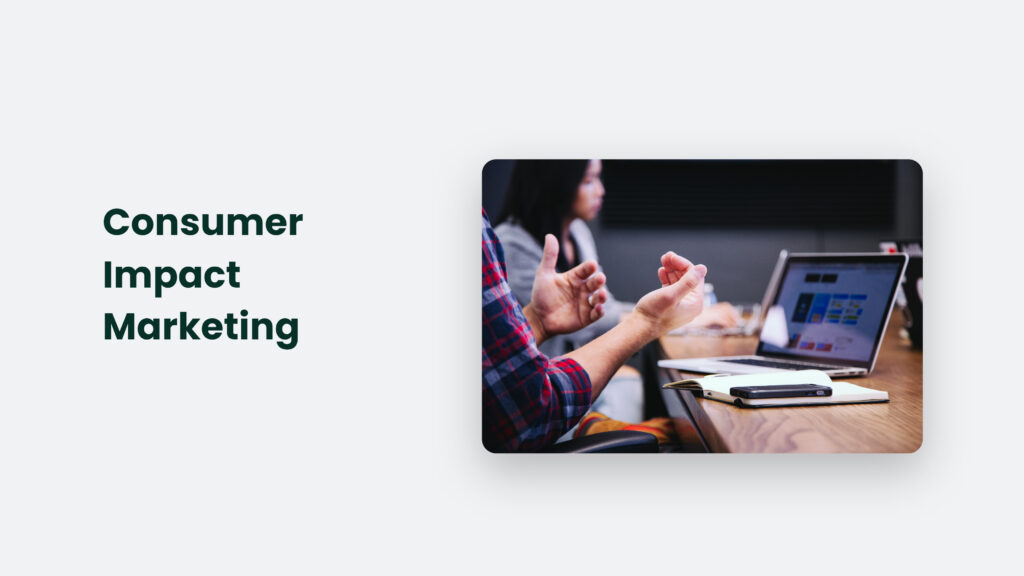

Consumer Impact Marketing: The Future of Business in 2023

As Seen On
As a marketer, I always seek new and innovative ways to reach consumers and drive client results. And over the past few years, I’ve noticed a growing trend in the marketing world: consumer impact marketing.
But what exactly is consumer impact marketing, and why is it so important for businesses today?
Let me break it down for you.
Consumer impact marketing is a marketing approach that focuses on positively impacting consumers’ lives rather than simply promoting a product or service. It’s about connecting with consumers deeper and creating a meaningful relationship.
Think of it like this: instead of just trying to sell a product, you’re also trying to make a difference in someone’s life.

So, why is consumer impact marketing so important?
Well, for starters, we’re living in a world where consumers are becoming more and more conscious of their purchases’ impact on the world around them. They want to feel good about the products and services they buy and support companies that align with their values.
And that’s where consumer impact marketing comes in. By creating a positive impact on consumers’ lives, you’re not only selling them a product but also making a difference in their world. And that’s a powerful selling point.
But how exactly do you create a positive impact through your marketing?
It starts with understanding your target audience and what matters most to them. Are they concerned about the environment? Are they passionate about a particular cause? Once you understand what’s important to your target audience, you can create marketing campaigns that promote your products and positively impact the world.
For example, you’re a clothing company, and your target audience is environmentally conscious. You could create a line of sustainable clothing made from recycled materials and donate some of the profits to an environmental organization. It not only promotes your clothing but also makes a positive impact on the environment and supports a cause that’s important to your target audience.
But consumer impact marketing isn’t just about making a difference. It’s also about creating a deeper connection with your target audience. You create a relationship based on shared values when you show that you care about the same things they do. And that’s a relationship that can last a lifetime.
So, what are the benefits of consumer impact marketing?
- Increased brand loyalty: When you positively impact consumers’ lives, you’re selling them a product and creating a relationship based on shared values. And that’s a relationship that can last a lifetime.
- Improved brand image: By demonstrating that you care about more than just your bottom line, you’re improving your brand image and positioning yourself as a company that cares about making a difference.
- Increased sales: Consumers are becoming increasingly conscious of their purchases’ impact on the world around them. By creating a positive impact through your marketing, you’re appealing to their values and making it easier for them to choose your products over the competition.
- Increased customer engagement: When you positively impact consumers’ lives, you sell them a product and create a conversation. And that’s a conversation that can lead to increased customer engagement and loyalty.
- Competitive advantage: By incorporating consumer impact marketing into your strategy, you’re differentiating yourself from the competition and positioning yourself as a company that cares about making a difference.

So, now that you understand the importance of consumer impact marketing, how can you get started?
- Identify your target audience: The first step in creating a consumer impact marketing strategy is understanding your target audience and what matters most to them. What are their values and beliefs? What causes do they support? By understanding what’s important to your target audience, you can create marketing campaigns that resonate with them and positively impact their lives.
- Choose a cause that aligns with your brand: Once you understand what’s important to your target audience, it’s time to choose a cause that aligns with your brand. Choose a cause you’re passionate about that aligns with your brand’s values. It could be anything from environmental conservation to supporting local communities.
- Create a marketing plan: Once you’ve identified your target audience and chosen a cause, it’s time to create a marketing plan. Ensure that your marketing plan aligns with your brand’s values and supports your chosen cause. It should include your goals, target audience, messaging, and tactics.
- Partner with a non-profit: One of the best ways to make a positive impact through your marketing is to partner with a non-profit that supports your chosen cause. It not only helps you make a bigger impact, but it also helps you build relationships with organizations that can help you reach your target audience.
- Measure your impact: Finally, make sure you measure the impact of your consumer impact marketing campaigns. It will help you understand what’s working and what’s not and give you the data you need to make informed decisions about your marketing strategy.
In conclusion, consumer impact marketing is the future of business. By creating a positive impact on consumers’ lives, you’re not only selling them a product but also making a difference in their world. And that’s a powerful selling point. So, get started today and start making a positive impact!
Frequently Asked Questions:
What is consumer impact marketing?
Consumer impact marketing is a marketing approach that focuses on positively impacting consumers’ lives rather than simply promoting a product or service.
Why is consumer impact marketing important?
Consumer impact marketing is important because it appeals to consumers’ values and creates a deeper connection. It also helps businesses differentiate themselves from the competition and improves their brand image.
What are the benefits of consumer impact marketing?
The benefits of consumer impact marketing include increased brand loyalty, improved brand image, sales, customer engagement, and competitive advantage.
The Bottom Line:
As you can see, consumer impact marketing is a powerful tool that can help you build deeper relationships with your customers and positively impact their lives. By following the tips outlined in this piece, you can create successful consumer impact marketing campaigns that drive business growth and positively impact the world. So why wait? Get started today and start making a difference!
Konger
Up until working with Casey, we had only had poor to mediocre experiences outsourcing work to agencies. Casey & the team at CJ&CO are the exception to the rule.
Communication was beyond great, his understanding of our vision was phenomenal, and instead of needing babysitting like the other agencies we worked with, he was not only completely dependable but also gave us sound suggestions on how to get better results, at the risk of us not needing him for the initial job we requested (absolute gem).
This has truly been the first time we worked with someone outside of our business that quickly grasped our vision, and that I could completely forget about and would still deliver above expectations.
I honestly can't wait to work in many more projects together!
Disclaimer
*The information this blog provides is for general informational purposes only and is not intended as financial or professional advice. The information may not reflect current developments and may be changed or updated without notice. Any opinions expressed on this blog are the author’s own and do not necessarily reflect the views of the author’s employer or any other organization. You should not act or rely on any information contained in this blog without first seeking the advice of a professional. No representation or warranty, express or implied, is made as to the accuracy or completeness of the information contained in this blog. The author and affiliated parties assume no liability for any errors or omissions.

